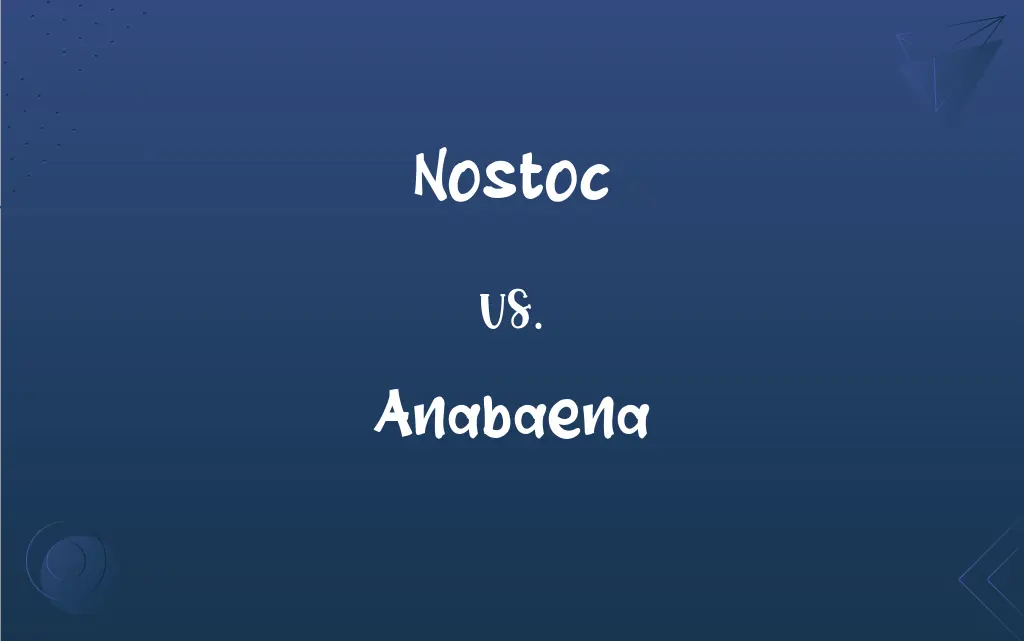Nostoc vs. Anabaena: What's the Difference?
Edited by Aimie Carlson || By Harlon Moss || Published on February 23, 2024
Nostoc is a genus of cyanobacteria forming gelatinous colonies, known for nitrogen fixation; Anabaena, also a cyanobacteria, forms filaments and is noted for its role in water blooms.

Key Differences
Nostoc forms spherical or irregularly shaped colonies enclosed in a gelatinous matrix, while Anabaena is characterized by long, filamentous chains. Both are cyanobacteria, but their colony formation differs distinctly.
Both Nostoc and Anabaena are capable of nitrogen fixation, but Nostoc is more commonly recognized for this ability, often found in soil or water. Anabaena, while also fixing nitrogen, is more noted for its presence in water blooms.
Nostoc is versatile, thriving in diverse environments from water to moist soil, often in symbiotic relationships. Anabaena predominantly inhabits freshwater bodies and is frequently associated with algal blooms.
In Nostoc, cells differentiate into heterocysts, akinetes, and vegetative cells. Anabaena also forms heterocysts for nitrogen fixation, but the differentiation patterns and frequency can vary compared to Nostoc.
Nostoc plays a vital role in soil fertility and ecosystem balance, while Anabaena is known for its contribution to nutrient cycling in aquatic ecosystems but can also cause harmful algal blooms.
ADVERTISEMENT
Comparison Chart
Colony Formation
Forms gelatinous, spherical colonies
Forms long, filamentous chains
Nitrogen Fixation
Widely recognized for this ability
Also fixes nitrogen, known in blooms
Preferred Habitat
Diverse, including water and soil
Predominantly in freshwater bodies
Cell Differentiation
Heterocysts, akinetes, vegetative
Similar but varying patterns
Environmental Role
Soil fertility, ecosystem balance
Nutrient cycling, potential for blooms
ADVERTISEMENT
Nostoc and Anabaena Definitions
Nostoc
Nostoc is a cyanobacterium forming gelatinous colonies.
The green, jelly-like substance on the pond's surface was identified as Nostoc.
Anabaena
Anabaena is a filamentous cyanobacterium often found in freshwater.
The filamentous structures observed in the lake water were identified as Anabaena.
Nostoc
Nostoc can exist in symbiotic relationships with plants.
In the roots of some plants, Nostoc provides essential nitrogen.
Anabaena
Anabaena undergoes nitrogen fixation, crucial for aquatic ecosystems.
Anabaena plays a significant role in the nitrogen cycle of freshwater habitats.
Nostoc
Nostoc contributes to the ecological balance in diverse habitats.
In the wetland ecosystem, Nostoc played a crucial role in maintaining ecological balance.
Anabaena
Anabaena can form specialized cells called heterocysts for nitrogen fixation.
Under a microscope, the heterocysts of Anabaena were clearly visible.
Nostoc
Nostoc is resilient, surviving in harsh environmental conditions.
Despite the arid conditions, Nostoc thrived on the desert's crust.
Anabaena
Anabaena is noted for its role in forming harmful algal blooms.
The proliferation of Anabaena was responsible for the toxic algal bloom.
Nostoc
Nostoc is known for nitrogen fixation, enriching soil nutrients.
Farmers appreciated Nostoc in their fields for its soil-enriching qualities.
Anabaena
Anabaena contributes to nutrient cycling in aquatic environments.
Anabaena's presence is essential for the nutrient dynamics of this aquatic ecosystem.
Nostoc
Any of various freshwater nitrogen-fixing cyanobacteria of the genus Nostoc that form spherical colonies of filaments embedded in a gelatinous substance.
Anabaena
Any of various freshwater cyanobacteria of the genus Anabaena that sometimes occur in drinking water and cause a bad taste and odor.
Nostoc
Any member of the genus Nostoc of cyanobacteria, found in a variety of environmental niches, that form colonies composed of filaments of moniliform cells in a gelatinous sheath.
Anabaena
Any cyanobacterium of the genus Anabaena.
Nostoc
A genus of algæ. The plants are composed of moniliform cells imbedded in a gelatinous substance.
Nostoc
Found in moist places as rounded jellylike colonies
FAQs
Where is Nostoc commonly found?
In water, moist soil, and in symbiotic relationships with plants.
What is Anabaena?
A filamentous cyanobacteria, often associated with water blooms.
How does Nostoc contribute to soil health?
Through nitrogen fixation, enriching soil nutrients.
Can Nostoc survive in harsh conditions?
Yes, it's known for its resilience in various environments.
What distinguishes Anabaena's structure?
Its long, filamentous chains.
What is Nostoc?
A cyanobacteria forming gelatinous colonies, known for nitrogen fixation.
Where does Anabaena typically occur?
Mostly in freshwater environments.
Is Nostoc beneficial for agriculture?
Yes, it can improve soil fertility.
Does Nostoc have any symbiotic relationships?
Yes, with plants and some fungi.
How does Anabaena fix nitrogen?
Through specialized cells called heterocysts.
How is Nostoc used in research?
In studies on nitrogen fixation and symbiosis.
What precautions should be taken around Anabaena blooms?
Avoid contact with the water and don't consume affected fish.
What environmental issues can Anabaena cause?
It can lead to harmful algal blooms in water bodies.
How does Anabaena affect water quality?
It can degrade water quality through algal blooms.
What types of cells does Nostoc differentiate into?
Heterocysts, akinetes, and vegetative cells.
Can Nostoc be visible to the naked eye?
Yes, as gelatinous green clumps or mats.
Is Anabaena always harmful?
Not always, but it can be under certain conditions.
What role does Anabaena play in aquatic ecosystems?
It's important for nutrient cycling but can cause blooms.
What is the ecological importance of Nostoc?
It balances ecosystems and enriches soils.
Can Anabaena be controlled in water bodies?
Yes, through various environmental management practices.
About Author
Written by
Harlon MossHarlon is a seasoned quality moderator and accomplished content writer for Difference Wiki. An alumnus of the prestigious University of California, he earned his degree in Computer Science. Leveraging his academic background, Harlon brings a meticulous and informed perspective to his work, ensuring content accuracy and excellence.
Edited by
Aimie CarlsonAimie Carlson, holding a master's degree in English literature, is a fervent English language enthusiast. She lends her writing talents to Difference Wiki, a prominent website that specializes in comparisons, offering readers insightful analyses that both captivate and inform.







































































